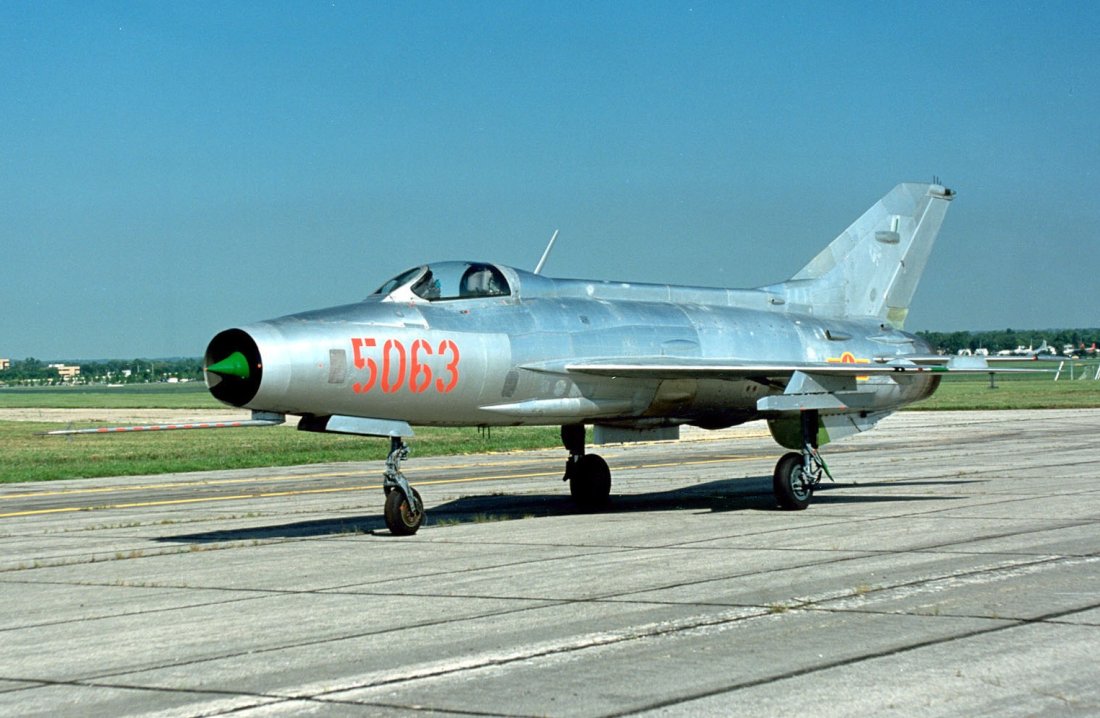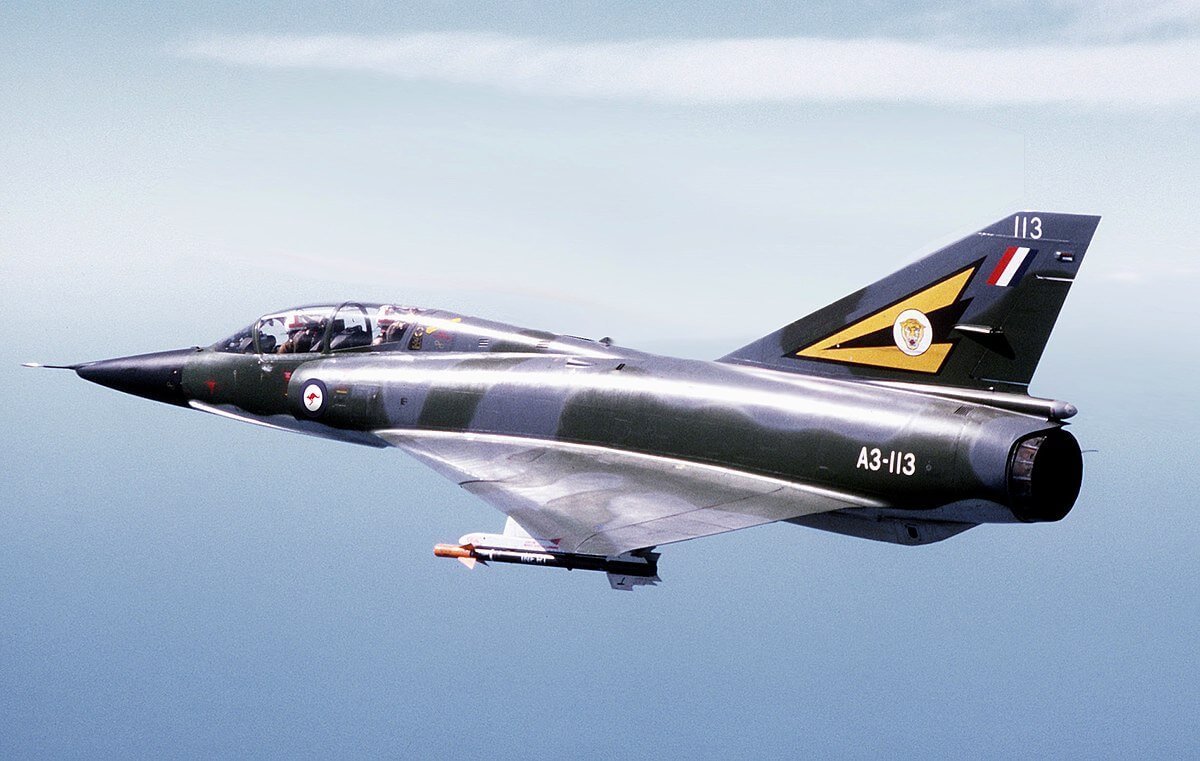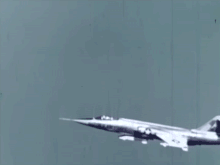When the first generation of jets arrived in combat, their speed was revolutionary, allowing them to reign supreme over the slower propeller-driven fighters. But the designers kept innovating, inventing new theories and techniques to allow faster flight. Afterburners arrived, as did cleverly-designed 'area rule' fuselages that decreased drag at high mach numbers. These made aircraft more powerful, but now they were too fast to use guns very well. This generation saw the widespread introduction of air-to-air missiles, which allowed extremely accurate combat at longer ranges. These missiles were far from perfect and were fairly easy to evade, but they paved the way for future generations of missiles.
 |
| The first supersonic plane, the Bell X-1 |
English Electric Lightning
Being one of the closest countries to the Soviet Bloc, the UK was feeling threatened by the USSR's nuclear bombers. Since there wouldn't be much time between the detection of the bombers and nuclear annihilation, the UK needed a fighter-interceptor with a dazzling climb rate. This necessitated two engines but the engines at the time were somewhat unreliable. If the engines were next to each other, failure in a single engine would cause the plane to spin to one side, with potentially fatal effects. So the decision was taken to outfit the amazingly fast Lightning with the two engines stacked one above the other.
 |
| Vertical at full afterburner |
Under the aforementioned threat of nuclear apocalypse, the UK determined that runways were a very vulnerable target for an initial strike. Thus, a requirement was issued for an aircraft capable of either short takeoffs or vertical takeoff. Thus, Hawker built the Harrier around the specially-designed Rolls-Royce Pegasus engine. The original aircraft had an appalling attrition rate, but later marks improved the reliability. Surprisingly, one large customer was the US Marine Corps, as the Harrier was able to operate from almost any ship with a helipad (during the Falklands conflict one landed on a container ship). Even today it is one of only two production vertical takeoff fighters ever made.
 |
The USA
Convair F-106 'Delta Dart'
The F-106 was built to be the ultimate interceptor: insanely fast, well-armed, and an insane climb rate (29,000 feet per minute). It could go 2.3 times the speed of sound and carried a massive 20mm rotary cannon and two infra-red or radar homing missiles. This thing was a bomber destroyer, pure and simple. After it was retired in the 80's, many were converted to pilot-less drones and shot down in missile tests.
Lockheed F-104 Starfighter
Convair F-106 'Delta Dart'
The F-106 was built to be the ultimate interceptor: insanely fast, well-armed, and an insane climb rate (29,000 feet per minute). It could go 2.3 times the speed of sound and carried a massive 20mm rotary cannon and two infra-red or radar homing missiles. This thing was a bomber destroyer, pure and simple. After it was retired in the 80's, many were converted to pilot-less drones and shot down in missile tests.
 |
| "Fox 2! Fox 2!" |
There's no other way to put it. This aircraft was insane. Lockheed consulted pilots flying over Korea and found that they wanted a small, simple plane with excellent performance. To obtain this performance, the wings were made to perform very well at high speeds. This required them to be extremely thin, so thin that they presented a cut hazard to ground crew and had to have protectors fitted while on the ground. As if this wasn't already sketchy enough, the ejection seat fired downwards, meaning that low-altitude ejection was suicide. Pilots quickly dubbed the F-104 the "Missile With a Man in it"
France
North American F-100 Super Sabre
Designed as a follow-on the the small F-86 Sabre discussed previously, the F-100 was supposed to be a powerful air-superiority fighter. Over Vietnam, it was adapted into a fighter-bomber, working alongside the bigger and faster F-105 Thundercheif.
 |
France
Dassault Mirage III
In the late 50's, France wanted in on the jet fighter game. They had a few mediocre fighters and bombers, but nothing special. Dassault, having done some research on tailless delta aircraft, submitted the Mirage III to the French. During the tests, the Mirage became the first plane to go twice the speed of sound in level flight. It spawned a whole series of legendary aircraft.
The USSR
Mikoyan-Gurevich MiG-21
This jet has surpassed the realms of superlatives. It was that good. It was also a very Soviet design. It was built as cheaply and quickly as possible. Damaged aircraft were simply replaced. Designed as an interceptor, it had an absolutely crazy climb rate of 44,000 feet per minute, and was armed with four to eight air-to-air missiles. Even though it was relatively slow (only 1.7 times the speed of sound), it served many Soviet-influenced nations very well. It is still the most-produced supersonic jet. Fun fact: upon taking off, the MiG-21 had only about 30 minutes of fuel, making it one of the shortest-ranged warplanes.
 |
| Even on the apron it looks fast |
.jpg)


1 comment:
Nice job! I think you were very thorough and helpful in your explanations of the aircrafts' features, circumstances for being built, and country-specific characteristics. Before reading this, I was unfamiliar with the origins of jets and their generations. Additionally, I enjoyed your word choice and bonus clip!
Post a Comment